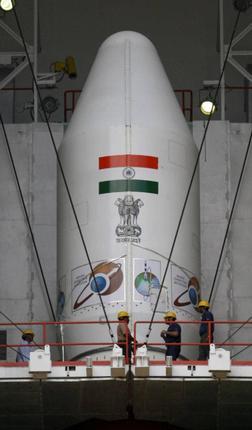Chennai, November 3: India’s ambitious mission to Mars moved ahead smoothly on Sunday with the 56.5- hour countdown beginning at 6.08 a.m. at the Sriharikota spaceport. If the countdown progresses without any “hold,” the four-stage Polar Satellite Launch Vehicle (PSLV-C25) will lift off from the first launch pad at 2.38 p.m. on Tuesday (November 5) and put the 1,350-kg Mars Orbiter in a long, elliptical earth-orbit. That will signal the first step of the spacecraft’s 300-day odyssey to the Red Planet.
“All is well. The countdown is progressing smoothly. Everything is fine,” Director of Vikram Sarabhai Space Centre (VSSC) in Thiruvananthapuram S. Ramakrishnan told The Hindu from Sriharikota around 7 p.m. on Sunday.
“We are relaxed,” said M.Y.S. Prasad, Director of Satish Dhawan Space Centre (SDSC) at Sriharikota.
Both Mr. Ramakrishnan and Dr. Prasad said separately that the filling of the PSLV-C25’s fourth stage with liquid propellants was completed just minutes ahead of 7 p.m. on Sunday. The second stage would be filled with liquid propellants on Monday. The first and third stage were filled with solid propellants.
K. Radhakrishnan, Chairman of Indian Space Research Organisation (ISRO), said the cost of the Mars mission was about Rs.460 crores. This included building the spacecraft and the ground radar stations and augmenting the capacity of ISRO’s Deep Space Network Station at Byalalu, near Bangalore.
Asked about the criticism that a “poor” country like India is wasting money on sending a spacecraft to Mars, Dr. Radhakrishnan said, “We want to tell this country that Mars has a relevance…Science leads to understanding… Some people ask, “Why are you spending Rs.460 crores?” Others will say that Rs.460 crores is only some four rupees per head in this country. Then some others will say it is only the price of an aircraft. So there are different ways of looking at it…We want to tell this country that this is a complex mission.”
M. Annadurai, Programme Director of Indian Remote-sensing Satellites and Small Satellites Systems, ISRO, called the Mars Orbiter Mission “a logical extension of Chandrayaan-1.” “The mission profile is similar to that of the moon mission. The powerful PSLV-C25, which put Chandrayaan-1 into orbit, will swing into action in the Mars mission also.
After the Chandrayaan-1 mission in 2008, ISRO chose to head towards Mars because there are several similarities between the Earth and Mars. They include solid surfaces, seasons, the duration of their day and the polar ice caps. Also, if water exists on Mars, there may be microbial life on the planet.
After India established itself among world leaders in building application-oriented remote-sensing, communication, weather and surveillance satellites, which were “our bread and butter missions,” it was “a natural corollary” that India should turn its attention to science satellites, ISRO scientists said. Hence Chandrayaan-1, the Mars mission, Chandrayaan-2 in 2016, Astrosat for study of cosmic sources and Aditya-1 to study the solar corona.
Suspenseful 43 minutes
Unlike the previous PSLV missions, which lasted about 18 minutes to put remote sensing satellites into orbit, the flight duration of PSLV-C25 will last a suspenseful 43 minutes before the rocket’s fourth stage puts the spacecraft into orbit. “This is the speciality of the mission,” said B. Jayakumar, Vehicle Director.
As Mr. Jayakumar and R. Hutton, Associate Vehicle Director, stood a couple of hundred metres in front of the Mobile Service Tower encasing the four-stage PSLV-C25 on October 30, they asserted that “the PSLV is a rain-proof vehicle.”
V. Seshagiri Rao, Associate Director, SDSC, said several ground stations, including two ship-borne radars in the South Pacific Ocean, would track the vehicle and its positional information would be received every 100 milliseconds.

